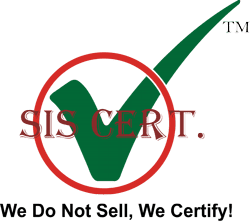What is ISO 13485 for Medical Devices?
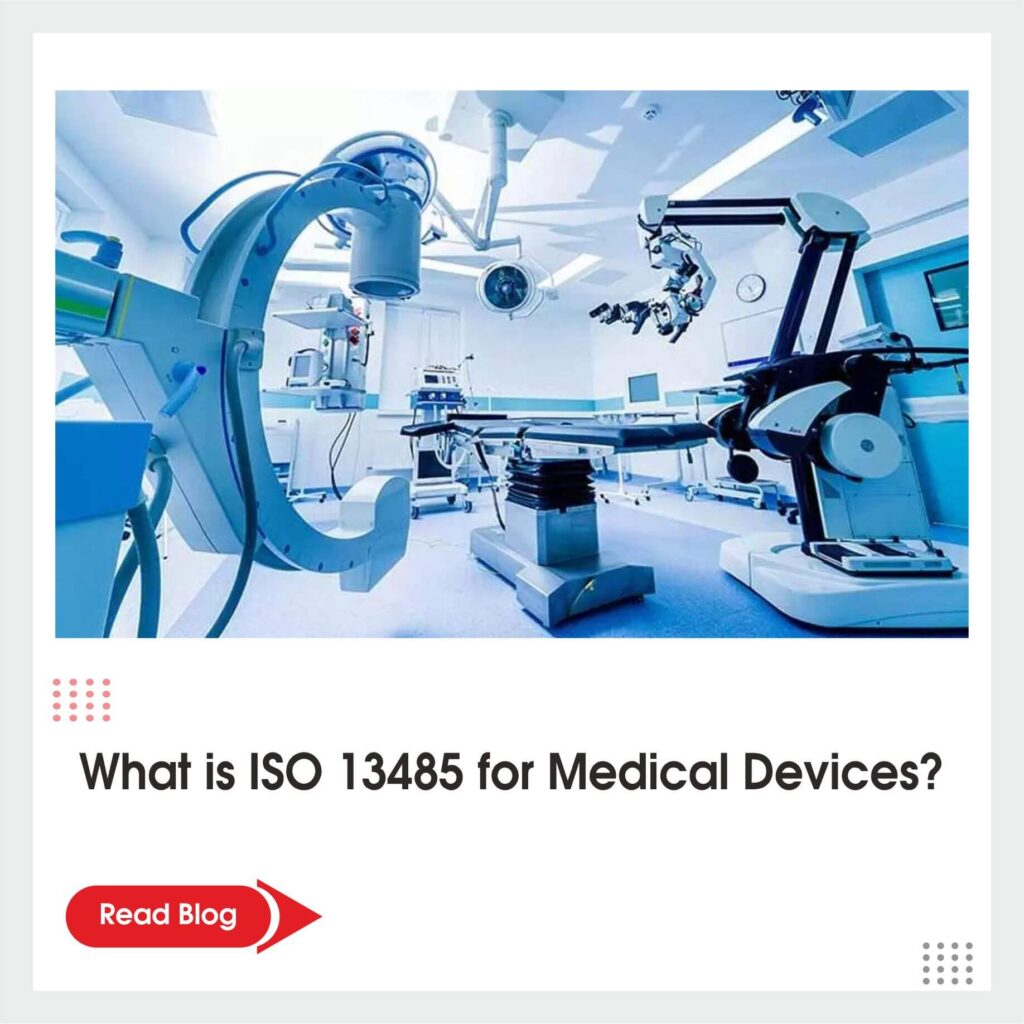
The Medical Industry forms a very significant part of the economy. However, the medical device industry is the next big emerging market worldwide that helps people fight odd health conditions and make life easy and comfortable. When it comes to medical devices, quality and safety are crucial. Manufacturers and suppliers follow strict guidelines to guarantee their products meet stringent quality and legal criteria. ISO 13485 standard is one such standard that addresses medical device quality management systems (QMS) for medical devices. What is ISO 13485:2016 Certification? ⮯ ISO 13485 is the primary Quality Management System (QMS) standard for medical devices, and various nations have their laws. The Food and Drug Administration (FDA) regulations for medical devices harmonise with ISO 13485 in the United States. The most recent version, released in March 2016, is ISO 13485:2016. The entire life cycle of a medical device is covered by ISO 13485:2016, including design and development, manufacturing, distribution, storage, installation, and servicing. It also includes providing related services like technical assistance or designing and developing. ISO 13485: A specific standard for medical devices based on QMS ⮯ An organisation utilises a quality management system (QMS) to plan, implement, monitor, and improve its performance to meet its goals. QMS standards are collections of policies, procedures, processes, and resources. It helps an organisation in the following ways: It establishes a systematic and consistent approach to managing its activities and processes with the help of a QMS built on ISO 13485:2016. It showcases that the organisation is capable of offering connected services and safe and reliable medical equipment. It meets the needs and expectations of the consumer and makes them happier. It respects relevant legal regulations and makes it easier for people to access the market. It helps organisations to determine and take advantage of opportunities and dangers. It enhances both an organisation’s overall performance and QMS constantly. Importance of ISO 13485 Certification for Medical Device Industry ⮯ ISO 13485:2016 standard is important for an organisation due to the following reasons: ISO 13485 contributes to the safety and efficacy of medical devices and associated services. Moreover, the certification provides a systematic approach for organisations to implement appropriate quality control and ongoing enhancement. ISO 13485 standard helps organisations to adhere to relevant regulatory and international standards concerning medical devices. The standard also provides a comprehensive structure for organisations to maintain compliance with the regulations and make audits and inspections easier. Five key elements of ISO 13485 standard ⮯ Quality Management System Management Responsibility Resource Management Product Realisation Measurement, Analyses, and Improvement Similarities between ISO 9001 and ISO 13485 Certification ⮯ ISO 9001 and 13485 standards help businesses in implementing a quality management system. The two standards emphasise conducting risk assessments to minimise potential threats and errors in the management system. ISO 9001 and 13485 standards use the effective PDCA cycle, sometimes called the Plan-Do-Check-Act cycle, to implement the principle of continuous improvement. The two standards focus on developing adequate infrastructure and competency for delivering quality products. ISO 9001 and 13485 standards require an organisation to identify the errors and shortcomings in the business operations to produce high-quality goods. Conclusion ✅ Organisations must adhere to ISO certification 13485:2016 for medical device quality management systems. The requirements of ISO 13485 enable the organisation to create and uphold a robust quality management system to deliver safe and effective medical devices to ensure customers’ safety and well-being. Organisations can improve customer satisfaction, reduce risks, and show dedication to achieving the desired goals and objectives.
A Step-by-Step Guide to Mastering Capability Maturity Model Integration (CMMI) Level 3

Obtaining CMMI (Capability Maturity Model Integration) Certification offers the optimal method for demonstrating a business’s reliability and dedication to its clients and customers! Information Technology (IT) Companies attribute success to producing high-quality products and adhering to a well-structured procedure that guarantees ongoing improvement. However, this is where the Capability Maturity Model Integration (CMMI) comes into the picture; it helps an organisation drastically improve its processes and systems by becoming CMMI Level 3 certified. CMMI Level 3 is the third level of the maturity model and is a critical achievement for businesses to demonstrate their commitment to providing high-quality goods and services. Obtaining this CMMI accreditation creates a positive and professional image for software and technology organisations. What is Capability Maturity Model Integration (CMMI) Certification? ⮯ CMMI (Capability Maturity Model Integration) is a widely known framework for process improvement that helps organisations improve business operations and security controls. It provides a comprehensive process roadmap to enhance the company’s performance and attain optimal results. Organisations that effectively implement well-defined business processes can achieve CMMI (Capability Maturity Model Integration) certifications. Organisations with CMMI certifications demonstrate their dedication, determination, effectiveness, and competence. They hold significant value and global recognition among customers and partners. What are the 5 Levels of Capability Maturity Model Integration (CMMI) Certification? ⮯ International organisations can get accredited by the CMMI Institute and receive CMMI certificates. Under the Capacity Level and Maturity Level, there are various certification levels. The first tiers till CMMI (Capability Maturity Model Integration) Level 3 within the CMMI group are listed here. Capability Maturity Model Integration (CMMI) Level 0: An organisation with capability level 0 has not yet established a well-thought-out practice area. Capability Maturity Model Integration (CMMI) Level 1: An organisation that has begun to improve its operations at the beginning level is represented by capability level 1. Capability Maturity Model Integration (CMMI) Level 2: An organisation that adheres to a straightforward but efficient practice area plan with well-defined procedures is represented by capability level 2. Capability Maturity Model Integration (CMMI) Level 3: Organisations that set end goals by adhering to established industry standards are at capability level 3. Maturity Levels Within Each Capability Maturity Model Integration (CMMI) ⮯ Maturity Level 0 denotes an organisation that has not yet successfully finished a project. The first maturity level, or Maturity Level 1, denotes an organisation that has not fulfilled its goals or deadlines. An organisation at Maturity Level 2 has unrelated tasks in the execution phase. A company at Maturity Level 3 employs a conventional strategy. This organisation meets deadlines while overcoming recurring problems. An organisation at Maturity Level 4 employs a data-driven strategy to achieve the project’s final objectives. An organisation at Maturity Level 5 has demonstrated ongoing improvement. It indicates that it has changed more quickly and effectively. Benefits of Capability Maturity Model Integration (CMMI) Level 3 Certification ⮯ Enhanced performance quality: An organisation with CMMI accreditation has established processes. It can deliver excellent results. Reliable delivery: Organisations with CMMI Level 3 certification include established and meticulously recorded protocols. It guarantees consistent and dependable product and service delivery. Lower risk:Capability Maturity Model Integration (CMMI) Level 3 certified businesses have established proactive measures to manage risks. As a result, clients feel more confident in their ability to provide the intended results. Boost productivity: Businesses must streamline their workflow and operational procedures to receive this accreditation. It enhances overall productivity. Conclusion ✅ A carefully thought-out and implemented process improvement strategy that includes gap analysis, implementation, and formal assessment is necessary to achieve certification. Nonetheless, the advantages of obtaining CMMI (Capability Maturity Model Integration) Level 3 certification, like enhanced productivity, superior quality, and a competitive edge, make the effort valuable. Success in the software development business will largely depend on an organisation’s ability to change and adapt to shifting industry norms and customer expectations. In this regard, CMMI Level 3 accreditation will be essential. Tags
Understanding GDPR Guidelines: Best Practices for Data Protection
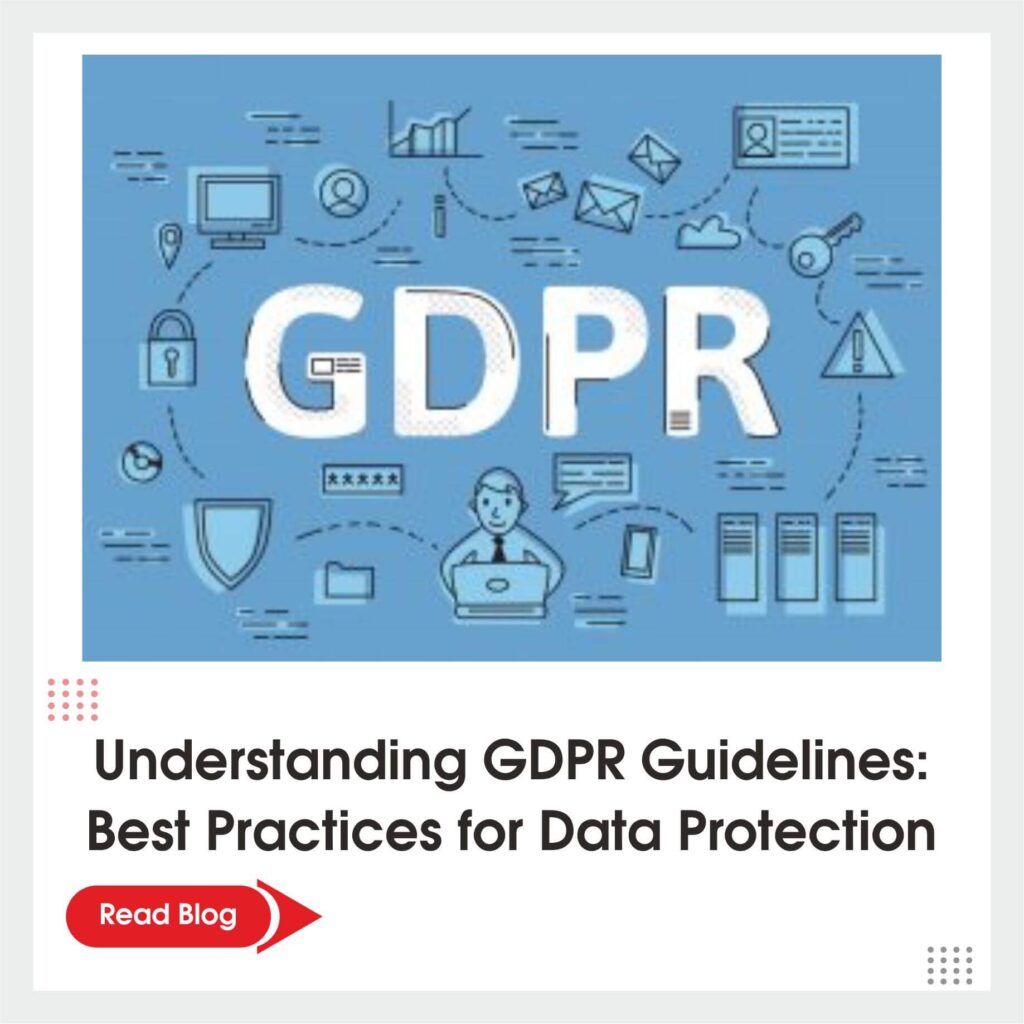
Legislation pertaining to digital privacy, known as the General Data Protection Regulation (GDPR), governs how businesses gather, utilize, and protect the personal information of EU citizens. Personal data transfers outside of the European Union are likewise governed by the regulations. Whatever personal information about EU individuals is stored, whether inside or outside the EU, will be subject to the GDPR. Firms must be aware of and prepared for the new regulations because the majority, if not all, process personal data, whether about customers or employees. The GDPR law defines personal data as any information identifying a specific individual, including name, photograph, email address, bank information, updates on social networking websites, location information, medical data, and computer IP address. Some Basic Rights of GDPR Right to access – This means that individuals may ask to see their data and find out how the company utilizes it once it has been gathered. The company is required to provide a free electronic copy of the personal data upon request. Right to be Forgotten – If a consumer no longer wants to be a client, they can ask for their data to be deleted or withdraw their permission for a business to use it. Right to data portability: Individuals are entitled to the freedom to switch service providers without losing their data. It also has to be finished in a way that is machine-readable and widely recognized. Right to be informed – This covers any data that companies may acquire, and people have the right to know before data acquisition. To allow data collection, consumer consent must be sought clearly. Right to correction – This ensures that individuals can have inaccurate, incomplete, or out-of-date information amended. Right to limit processing – People are entitled to ask that their data not be processed. Their record could be retained even if it isn’t in use. Right to object – this covers the person’s ability to stop their personal information from being processed for direct marketing purposes. This criterion cannot be waived, and processing of the request must stop as soon as it is received. In addition, people have to be informed of this directly at the beginning of every contact. Notification right – When someone learns of a data breach that exposes their personal information, they are entitled to notification within 72 hours. Data Protection Principles Lawfulness, fairness and transparency – The first principle, which highlights complete transparency for all EU data subjects, maybe the most significant. Businesses that collect data need to be transparent about their motivations and intended uses. Organizations must respond quickly when people ask questions about how their data is processed. When collecting, utilizing, and revealing data, the law must be observed. Purpose limitation – Organizations must have a clear and justified purpose to gather and use personal information. The data should only be processed for the objective for which it was collected and acquired unless the data subject has given specific consent. When processing is done for historical, statistical, scientific, or public archiving, a bit more wiggle room is allowed. Data minimisation – Compliance with the General Data Protection Regulation (GDPR) mandates that data be “sufficient, pertinent, and restricted to what is essential concerning the objectives for which they are handled.” Put differently, companies should only retain the absolute minimal amount of data required to achieve their objectives. Organizations must do more than just collect personal data in case it comes in handy later. They are most likely breaking the law if they are keeping more data than is necessary. Accuracy – Truthfulness, applicability, and timeliness are required for personal data. This means that businesses should regularly review the information they hold about specific persons and update or delete any inaccurate information as appropriate. Within 30 days, individuals can request that inaccurate or lacking data be deleted or rectified. The information will be made simpler, improving compliance and ensuring that firm records are accurate and current. Storage limitation – Personal data should be deleted or destroyed if it is no longer required for the purpose for which it was collected unless there are still valid grounds to retain it. The GDPR makes no mention of how long you should keep personal data. Your business will have to make this decision based on the grounds for processing. Database cleansing organizations must have a review process in place to ensure adherence. There are a few exceptions to the rule that says you cannot save personal data for future use, as in the case of study, statistical analysis, or archiving. Integrity and Confidentiality – Only safety is covered by this principle. To secure the personal information it has, your business must ensure that the appropriate security measures are in place. There may be security against internal hazards such as unauthorised usage, unintentional loss, or damage, in addition to protection against external threats like malware, phishing, and theft. Your systems, personnel, and services might be disrupted by inadequate information security. The GDPR requires businesses to put in place suitable security measures to reduce risks related to the data they handle, even though there isn’t a “one size fits all” solution. Accountability – The new GDPR principle states the need for enterprises to show that they have complied with the prior principles and they are responsible for the data they own. An organization is liable to provide the pieces of evidence of the actions they have performed to show that they are GDPR compliant. Analyzing the methods utilized currently Designating a Data Protection Officer Making an inventory of one’s data Getting the relevant consent Conducting Impact Assessments on Data Protection Companies may guarantee compliance with the GDPR by following these guidelines while designing, implementing, and running their operations. Conclusion ✅ Lastly, Businesses which are developing must use the General Data Protection Regulation and abide by it (GDPR). The General Data Protection Regulation (GDPR) places a heavy emphasis on individual rights and the proper use of personal data, along with
ISO 21001 Continuous Improvement in Education Industry: Leveraging ISO 21001:2018 for Ongoing Growth
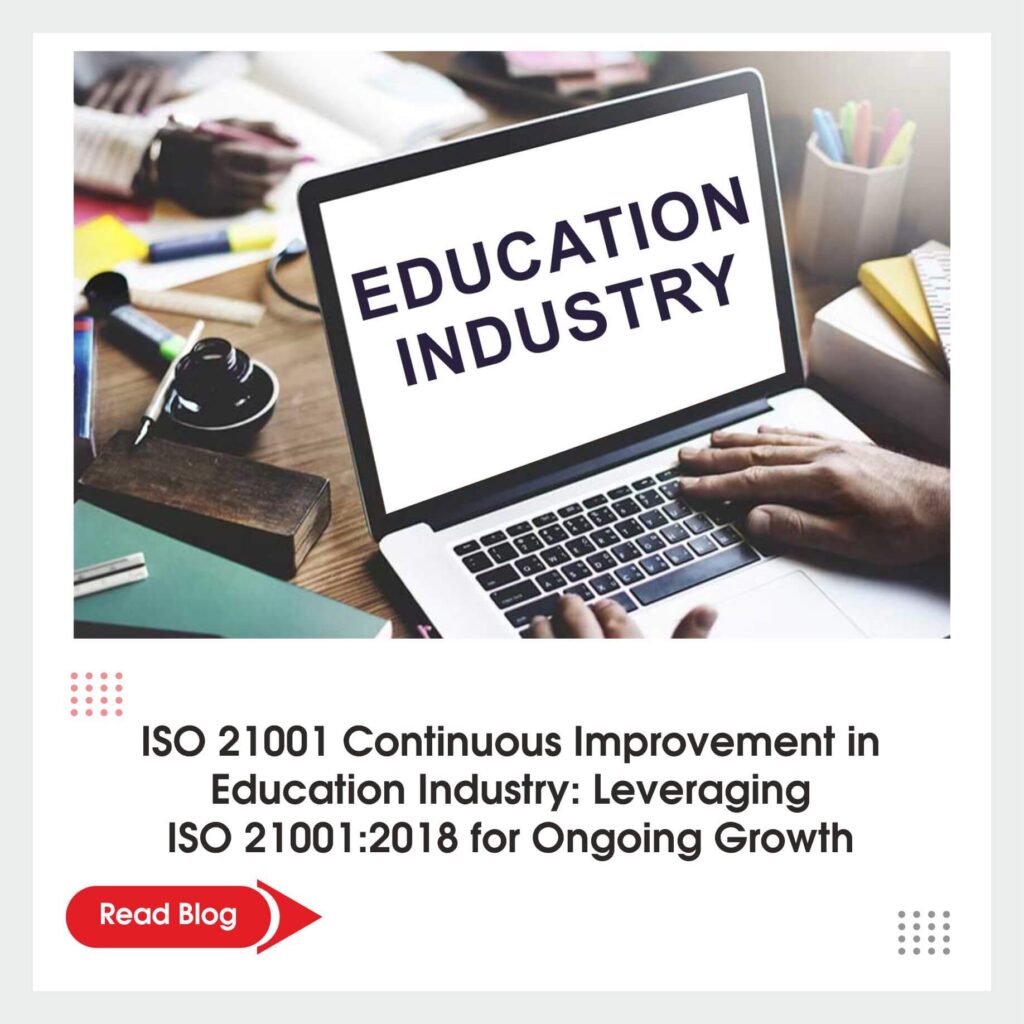
Introduction: Understanding the Importance of Continuous Improvement in Education ⮯ In every nation, education is the foundation of growth. In addition to altering people’s view of the outside world, it plays a significant part in bringing about good change by improving people’s thought processes and assisting them in discovering their passions. As a result, rather than being compromised, educational quality should always be improving and growing. ISO 21001 is a set of standards that apply to all educational organisations, regardless of size, kind, or location. To guarantee optimum compliance, the standard is particularly created for educational companies, considering elements such as complexity, maturity, and strategic direction and policies. An educational organization must be accredited with a quality management system, preferably based on the internationally known ISO 9001 standard, to fulfil the ISO 21001 requirement. The goal of ISO 21001 is to increase educational quality and student experience. As a result, the standard was created to apply to any educational organization, regardless of size or sector. It applies to institutions of higher learning, vocational training facilities, and e-learning services. ISO 21001’s purpose is to improve learning outcomes for learners. The Role of ISO 21001:2018 in Driving Continuous Improvement in Educational Institutions ISO 21001:2018 is critical in promoting continual improvement in educational institutions. Institutions may verify that they are offering high-quality education and addressing the requirements of their students by applying this internationally recognized educational standard. Its emphasis on quality management in education is one of ISO 21001’s main advantages. Establishing, implementing, maintaining, and continuously improving educational management systems is made easier for institutions with the help of this framework. Their activities become more effective and efficient overall as a result of this. The implementation of ISO 21001 facilitates the identification and resolution of issues that require improvement in educational institutions. Managing relationships, resources, and procedures inside the organization, promotes a methodical approach. Students’ outputs are enhanced, decision-making becomes more effective, and responsibility rises. Additionally, ISO 21001:2018 encourages educational institutions to have a continuous improvement culture. It motivates them to examine their procedures and key performance indicators regularly to spot areas that might need improvement. Adopting this standard would allow institutions to show that they are dedicated to fulfilling learners’ changing requirements and offering high-quality instruction. Key Elements of ISO 21001:2018 that Support Ongoing Growth and Development ⮯ ISO 21001 is a game-changing standard that provides a framework for educational institutions to improve their performance while also ensuring continual growth and development. The major aspects of ISO 21001 are intended to assist schools and other learning institutions in meeting their objectives and providing high-quality education. One of the most crucial components is educational leadership, which highlights the necessity of great leadership in promoting continual improvement and innovation. Educational institutions may establish a great learning atmosphere, engage their personnel, and inspire students to attain their full potential with excellent leadership. Schools may build an excellent culture and enable their stakeholders to participate in the institution’s continued growth and development by applying ISO 21001 principles. The learner-centered approach is another essential component of ISO 21001 standards. This implies that to provide students with individualized and fulfilling learning experiences, educational institutions should put their students’ needs and expectations first. Schools may better identify their specific requirements and modify their teaching strategies to fulfill them by putting the student at the heart of their operations. This component emphasizes how crucial it is for students to participate in decision-making processes and feel empowered to take charge of their education. Schools may establish a welcoming and encouraging learning environment that fosters student achievement and well-being by implementing the principles of ISO 21001. ISO 21001 highlights the significance of continuous improvement in addition to learner focus and educational leadership. This part pushes academic institutions to assess their performance regularly, pinpoint areas that require development, and put into practice practical plans to improve operations. Schools may cut down on inefficiencies, simplify procedures, and consistently improve the quality of their educational offerings by implementing a methodical approach to quality management systems. The institution itself gains from ISO 21001’s continued support for growth and development, and the education industry as a whole also gains from this. A blueprint for success in the quickly evolving world of today is provided by ISO 21001, which emphasizes essential components such as leadership, learner focus, and continuous development. The Impact of Continuous Improvement on Students’ Learning Experience and Outcomes ⮯ Continuous improvement in education is a key process that serves to guarantee that children receive the best education possible. This technique entails continuous reviewing and improvement in teaching methods, curriculum, and learning environments to find areas for improvement and make changes to improve student learning results. Continuous improvement is fundamentally about always striving for perfection. It necessitates the establishment of objectives and making improvements as and when required to meet their goals. This type of approach is very significant in education. There are several benefits to exercising a continuous improvement strategy in education. One of the most significant is that it helps children get a high-quality education that boosts their confidence and prepares them to work for their goals. Teachers will get up to date with the latest methods and research by regularly keeping an eye on the teaching techniques and curriculum. Fostering an innovative and collaborative culture among educators is another advantage of continual development. Continuous improvement has the potential to foster a community of educators committed to giving children the best education possible by empowering them to take prudent risks, try out novel strategies, and share their triumphs and disappointments. The promotion of equity in education is arguably the most significant benefit of continuous improvement. Through continuous assessment and improvement of teaching strategies and curricula, educators may spot and close gaps in learning outcomes and guarantee that every student has access to the tools and assistance they require to achieve. Key differences between ISO 27001 and 27701 Certification The security requirements of ISO 27001 include data protection principles and requirements in ISO/IEC 27701. Organisations must outline baselines
ISO 22000: Safeguarding Your Business and Customers through Food Safety Standards

Understanding the Importance of Food Safety in a rapidly growing era. Food safety is very important in the modern society. Customers have become more prudent about the quality and safety of the food they eat as a result of growing health and wellness knowledge and concerns. Consequently, companies in the food sector have to emphasize food safety and follow strict guidelines. Organizations must adhere to strict food safety regulations to be certified by ISO 22000, a globally recognized standard for food safety management systems. Adherence to ISO 22000 standards not only signifies a dedication to delivering secure and superior products but also amplifies client confidence. Enforcing proper procedures at every stage of production—from collecting raw materials to handling, storing, processing, and distributing the completed product—is the goal of the standards and legislation that control the food industry. They also aim to prevent contamination and minimize health risks. By implementing stringent food safety protocols, businesses may safeguard both their brand and the health of their clientele. Today’s customers want responsibility and honesty from the businesses they do business with. In addition to creating trust, proving your dedication to food safety gives you a competitive advantage in a congested industry. What is ISO 22000 and How Does it Ensure Food Safety? The ISO 22000 standard defines the standards for a food safety management system. An ISO 22000-compliant FSMS provides food manufacturers with a systematic strategy and the required tools to control the safety of their goods and services. ISO 22000, as part of the FSMS, requires the establishment of effective communication with interested parties, the implementation of a risk-based approach, the establishment and maintenance of prerequisite programs, hazard control plans (OPRPs and CCPs), the monitoring of FSMS and food safety performance, and the seeking and realization of opportunities for continuous improvement. ISO 22000:2018 integrates and complements the core aspects of ISO 9001 and HACCP to offer an appropriate framework for establishing, implementing, monitoring, and continuously improving a documented Food Safety Management System (FSMS) within the context of an organization’s overall business risks. The Benefits of Implementing ISO 22000 in Your Business ⮯ Organizations that have a strong FSMS in place are better able to react quickly and effectively to problems that might jeopardize the safety of their food. By doing this, they may stop possible contamination and other food safety problems in their tracks. Additionally, the organization can react appropriately to unforeseen events due to the presence of emergency preparedness. Implementing an ISO 22000-compliant FSMS can also boost corporate performance. Organizations may limit the likelihood of product recalls by recognizing and controlling food safety issues, which can be costly and detrimental to a company’s brand. Furthermore, firms that demonstrate a commitment to food safety may be able to differentiate themselves from rivals and attract new customers who value food safety and quality. The standard promotes a methodical approach to discovering, analyzing, and addressing food safety issues. This enables companies to make educated decisions on how to avoid or reduce possible threats. ISO 22000 accreditation displays a dedication to food safety and quality. This can boost consumer trust in the organization’s products and services. ISO 22000 is a globally recognized standard, which implies that enterprises certified to this standard are more likely to be accepted by foreign clients and partners. The Future of Food Safety: Emerging Trends and Technologies As we all are aware the e-commerce sector is expanding rapidly and food safety has become a top priority. With the expansion of the e-commerce sector, food safety has become increasingly critical. It has become very tough to guarantee the safety and quality of the food supply due to the rise of direct-to-consumer platforms and online meal delivery services. An innovative idea with great promise to solve these problems is blockchain technology. Chains from farm to fork may be traced and made transparent with blockchain technology. This enables clients to have complete knowledge about the origin, handling, and transportation of the food products they buy. Delivering perishable commodities within acceptable limits is made possible by blockchain technology, which enables real-time temperature monitoring throughout transportation. Lessening health concerns, also makes it possible to quickly identify and recall tainted or compromised items. Blockchain technology can help businesses increase customer confidence in e-commerce food supply chains by bringing transparency and responsibility to the table. Knowing that the food goods they have purchased have passed thorough safety inspections at every stage of the process will give consumers peace of mind. Additionally, by expediting regulatory compliance procedures, this technology helps firms. Audits become less time-consuming and more effective when precise and unchangeable data are accessible on the blockchain. Conclusion ✅ In conclusion, understanding the importance of food safety is vital for businesses operating in the food industry. By adhering to industry standards such as ISO 22000 and complying with relevant regulations, companies can prioritize consumer well-being while fostering trust and loyalty among their customer base.
Unlocking the Power of Trust: How SOC Certification Ensures Security and Compliance for Your Organization
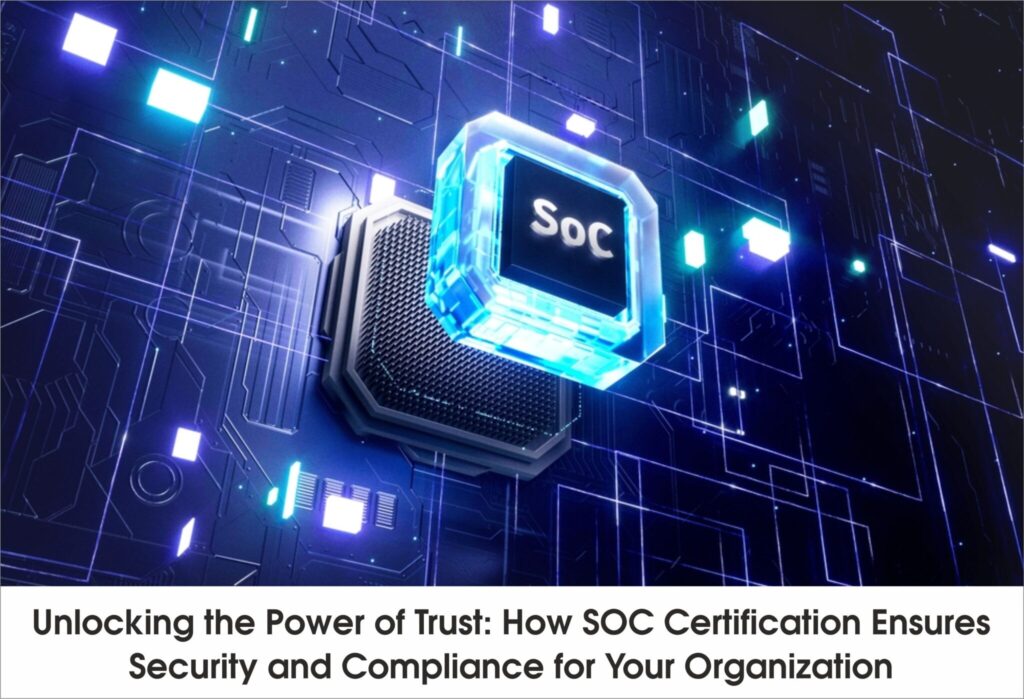
Introduction: Understanding the Importance of Security and Compliance ⮯ In today’s digital landscape, security and compliance have become paramount for businesses of all sizes. With the increasing number of cyber threats and data breaches, organizations must prioritize the protection of sensitive information and maintain the trust of their customers. One way to demonstrate a commitment to security and compliance is through obtaining a SOC (System and Organisation Controls) certification. SOC certifications provide an independent validation that an organization has implemented robust controls to safeguard data and ensure compliance with industry regulations. The importance of security and compliance goes beyond just protecting sensitive data. It also plays a crucial role in building organizational trust. Customers, partners, and stakeholders are more likely to engage with businesses that can demonstrate their dedication to protecting their information. Furthermore, adhering to security standards and regulations helps organizations avoid costly penalties and legal consequences associated with non-compliance. By implementing effective security measures, businesses can mitigate risks, prevent data breaches, and safeguard their reputation. In this section, we will explore the significance of security and compliance in today’s business environment. What is SOC Certification and Why is it Important? SOC (System and Organization Controls) certification is a crucial aspect of ensuring the security and privacy of data for service organizations. It is a set of standards developed by the American Institute of Certified Public Accountants (AICPA) to evaluate the control systems and processes implemented by these organizations. SOC certification provides independent verification that an organization has established effective internal controls and safeguards to protect client data. It assures clients that their sensitive information is handled securely and in compliance with industry best practices. One common type of SOC certification is SOC 2 compliance, which focuses on security, availability, processing integrity, confidentiality, and privacy. A SOC 2 report outlines the controls in place to meet these criteria and assures clients about the organization’s commitment to safeguarding their data. Obtaining a SOC certification demonstrates an organization’s dedication towards maintaining high standards of data security. It enhances trust between service providers and their clients, as it gives assurance that appropriate measures are in place to protect sensitive information from unauthorized access or misuse. The Benefits of Achieving SOC Certification for Your Organization ⮯ There are many advantages to obtaining SOC (System and Organization Controls) accreditation for your business. Some of the main benefits are as follows: Enhanced Trust and Credibility: SOC certification is regarded as the gold standard for data security and proves to stakeholders, investors, and clients that your business takes data security seriously. It improves your reputation in the marketplace. Improved Data Security: A thorough assessment of your organization’s security, availability, processing integrity, confidentiality, and privacy measures is required to acquire a SOC certification. This aids in locating any gaps in your data security and offers recommendations on how to fill them. Reduced Risk of Data Breaches: A SOC certification can greatly lower the risk of data breaches by identifying and resolving flaws in your data security. This could protect your company from significant monetary losses and reputational harm. Compliance with Regulations: Organizations must adhere to specific data security standards in several industries. A SOC certification can be used to show compliance with these rules, possibly protecting you from penalties or other sanctions. Attracting New Business: Numerous companies, especially bigger ones, need certain certifications like SOC from their suppliers and service providers. Thus, having a SOC certification can lead to new business opportunities. Efficiency in Audits: Once you have a SOC report, you may share it with interested parties, auditors, or prospective customers, which eliminates the need for additional audits. This can help you save time and money. Transparency: A SOC accreditation offers insight into your organization’s data security rules and procedures. Client and stakeholder trust may increase as a result of this transparency. Finally, even though obtaining SOC certification demands a time and resource commitment, the advantages it offers in terms of improved security, trust, and business potential make it a worthwhile endeavour for many businesses. How Does the SOC Certification Process Work? ⮯ The SOC (System and Organization Controls) certification process is an essential step for organizations looking to demonstrate their commitment to data security and privacy. This certification assures clients and stakeholders that the organization has implemented effective controls to protect sensitive information. The SOC audit process involves several key steps. First, the organization must identify which type of SOC report they need – either SOC 1, SOC 2, or SOC 3. Each report focuses on different aspects of controls and compliance. Once the type of report is determined, the organization must establish the criteria for SOC certification. This includes defining control objectives and identifying relevant control activities that will be assessed during the audit. These criteria are typically based on industry-specific standards such as ISO 27001 or NIST Cybersecurity Framework. Preparing for a SOC audit involves conducting a thorough assessment of existing controls and identifying any gaps or areas for improvement. This may involve implementing additional security measures, documenting policies and procedures, and ensuring that all employees are aware of their roles in maintaining data security. During the audit itself, an independent auditor will review the organization’s controls against the established criteria. This may involve interviews with key personnel, examination of documentation and evidence, and testing of systems and processes. Upon successful completion of the audit, the organization will receive a SOC report detailing its compliance with relevant control objectives. This report can then be shared with clients and stakeholders as evidence of their commitment to data security. Obtaining a SOC certification involves careful planning, implementation of robust controls, and undergoing a thorough audit process. It is an important step for organizations seeking to build trust with clients by demonstrating their commitment to protecting sensitive information. The Role of SOC Certification in Building Customer Trust and Winning Business Opportunities SOC accreditation is essential for gaining the trust of customers and landing lucrative business possibilities. Organizations that want to show that they are committed to
ISO Certifications for the Education Industry

ISO 9001 is an international standard for quality management systems. ISO 9001 is one of the most popular quality management system standards in the world today. It provides a framework for processes to systematically improve all areas of an organization. It is used by a huge range of organizations and is adapted to fit their unique business requirements. It can be applied to any organization, including educational institutions. Here’s how it can benefit an educational institution: Improved Quality of Education: The goal of ISO 9001 is to provide high-quality goods and services. This pertains to education and refers to offering top-notch teaching and learning opportunities. This can be accomplished by developing specific processes for lesson planning, the development of curriculum, training for teachers, and student assessment. Consistency: The standard requires organizations to consistently document and follow their processes. This ensures that all students receive the same education level, regardless of their teacher or class. Continuous Improvement: An obligation to continuously improve is part of ISO 9001. The quality of education may continue to advance as a result of the encouragement given to educational institutions to continuously assess and enhance their procedures. Increased Satisfaction: Educational institutions can boost worker, parent, and student satisfaction by putting a strong emphasis on quality and consistency. This may result in increased enrolment rates, better staff retention, and improved reputation in the community. Risk Management: The standard also emphasises risk-based thinking, which can assist educational institutions in spotting possible hazards and taking steps to mitigate them. Risks relating to student safety, financial viability, or observance of laws could be included in this. Transparency and Accountability: Transparency and accountability can be improved by documenting processes and keeping records as required by ISO 9001. This can increase credibility with stakeholders and make it simpler to show regulatory compliance. Efficiency: Educational institutions can become more efficient by identifying and eliminating unnecessary activities or redundancies. This helps to free up resources that may be used to raise educational standards. Meeting the requirements of the standard is only one part of getting ISO 9001 certification. The goal is to establish a culture of excellence and ongoing improvement that will be beneficial to the educational institution’s stakeholders over the long run. A globally recognised standard known as ISO 14001:2015 outlines the requirements for an Environmental Management System (EMS). Instead of setting environmental performance requirements, it offers a framework that organisations can follow. Implementing this standard will be extremely beneficial to educational institutions. The following are a few advantages: ⮯ Improved Environmental Performance: Institutions can use ISO 14001:2015 to identify, manage, monitor, and control their environmental challenges in a “holistic” way. Resource Efficiency: Institutions can find ways to reduce their waste and energy use by implementing an EMS, which will result in significant cost savings. Compliance with Legal Requirements: The standard lowers the danger of sanctions or legal action by assisting educational institutions in understanding and adhering to pertinent environmental laws and regulations. Enhanced Reputation: The ISO 14001:2015 accreditation shows an institution’s dedication to environmental responsibility, which can enhance the institution’s reputation among students, parents, staff, and the general public. Engagement of Staff and Students: Implementing ISO 14001:2015 can engage staff and students in environmental efforts, promoting a culture of sustainability and environmental awareness. Risk Management: Institutions can take proactive steps to control potential environmental impacts and assure ongoing development by recognising environmental risks and opportunities. Sustainable Development: The ISO 14001:2015 standard encourages organisations to consider all environmental issues that are pertinent to their operations, such as air pollution, water and sewage issues, waste management, soil contamination, mitigation and adaptation to climate change, and resource use and efficiency. Educational Opportunities: Student’s understanding of environmental management and sustainability can be improved through the process of adopting and maintaining an EMS by giving them opportunities for practical training. Stakeholder Engagement: The standard promotes increased participation of stakeholders, especially local communities, on environmental sustainability issues. Competitive Advantage: Having ISO 14001:2015 certification can give educational institutions a competitive edge in a world that is becoming more conscious of the environment, especially when it comes to attracting students and staff who value sustainability. Educational institutions that use ISO 14001:2015 can enhance their environmental performance as well as include sustainability in their methods of teaching and learning. Future leaders and citizens who take responsibility for the environment might reap advantages from this. ISO 45001:2018 is an international standard that offers organisations a framework for enhancing worker safety, lowering workplace risks, and establishing better, safer working conditions. The Occupational Health and Safety Management Systems (OHSMS) are the main area of focus. Implementing ISO 45001:2018 at an educational institution can provide the following advantages:: ⮯ Improved Safety: The main objective of ISO 45001 is to assist organisations in managing risks to occupational health and safety. This entails safeguarding the security of the faculty, students, and visitors by observing potential hazards and acting to mitigate them. Legal Compliance: Institutions can better understand and adhere to their legal and regulatory requirements for health and safety with the support of ISO 45001. By doing this, it may be possible to avoid fines and other consequences of noncompliance. Reduced Accidents and Illness: Institutions may substantially reduce the number of accidents or health problems among staff and students by concentrating on prevention and mitigation. Enhanced Reputation: Being ISO 45001 certified displays a dedication to health and safety. This could improve the institution’s reputation with parents, potential students, employees, and the general public. Increased Productivity: Less absenteeism and turnover result from a safer and healthier workplace, which may boost employee and student morale and productivity. Continual Improvement: The ongoing improvement culture that is emphasised by ISO 45001 encourages regular evaluation and enhancement of health and safety performance. Risk Management: The systematic approach to opportunity and risk management provided by ISO 45001 makes it simpler for educational institutions to anticipate, identify, and handle any operational disruptions. Stakeholder Engagement: The standard emphasises worker input and involvement, establishing a culture of engagement and safety inside the institution. Insurance Premiums: If an organisation
A Comprehensive Guide to Kosher Certification
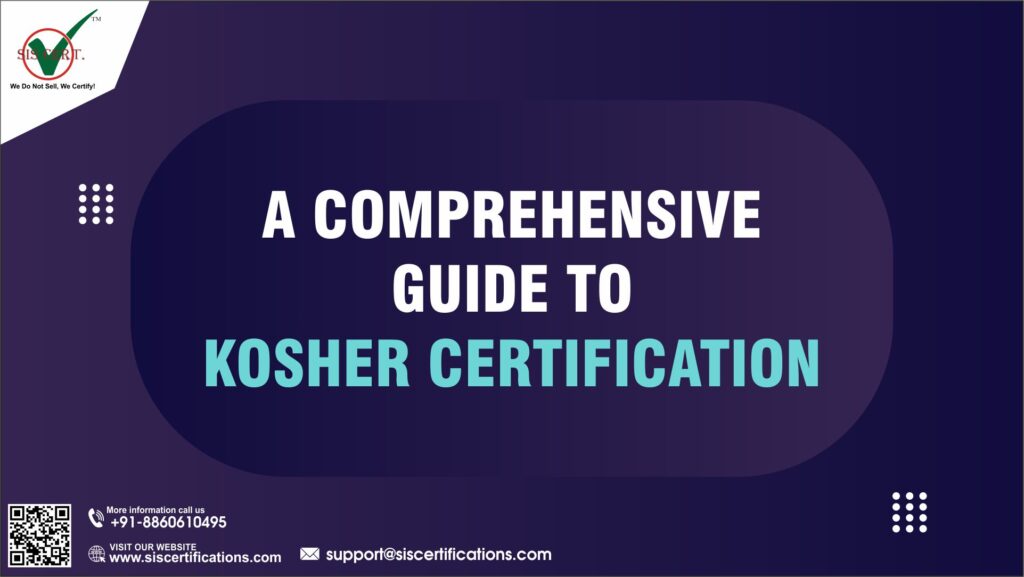
Introduction: What is Kosher Certification and Why is it Important? Kosher certification plays a significant role in ensuring that food products meet the requirements of Jewish dietary laws. It is a process by which food manufacturers and establishments obtain approval from trusted kosher certification agencies to label their products as “kosher.” This certification guarantees to consumers that the food they are buying and consuming complies with specific religious dietary requirements. The concept of kosher originates from Jewish traditions and practices, which dictate what foods are permissible for consumption. The Hebrew word “kosher” (which translates to “fit” or “proper”) refers to several regulations governing food preparation, ingredients, and handling. Kosher certification requires passing stringent inspections, audits, and compliance with particular standards established by accredited organizations. These organizations inspect every step of the manufacturing process to make sure that all ingredients are kosher-compliant and that there are no cross-contaminating elements. The significance of kosher certification extends beyond religious devotion. Many people maintain a kosher diet for cultural or health reasons. Furthermore, kosher certification helps attract a broader customer base by assuring individuals looking for completely kosher products. It is important to note that while similar in concept, halal certification pertains to Islamic dietary laws rather than Jewish ones. Both certifications share the common goal of providing consumers with confidence in the religious compliance of their food choices. The Process of Obtaining Kosher Certification for Food Products Obtaining kosher certification for food items is a detailed process that verifies compliance with Jewish dietary regulations. This certification is crucial for consumers who adhere to kosher dietary rules and want products that suit their religious requirements. The first stage in the kosher certification process is to apply to a recognized kosher certifying body. The application normally includes information about the company, its manufacturing methods, and the individual products seeking certification. It may also require information on ingredient sources and vendors. Once the application is received, the certifying agency will thoroughly review the information provided. This may involve analyzing ingredient lists, verifying suppliers’ certifications, and assessing manufacturing practices to ensure compliance with kosher standards. Following the review stage, a representative from the certifying agency will normally perform a facilities inspection. Various aspects of the production facility are evaluated during this inspection to ensure kosher compliance. This may entail inspecting equipment for hygiene, separating dairy and meat products, and ensuring overall kosher conformity. Another critical part of acquiring kosher certification is ingredient verification. The certifying agency will examine each component used in the product’s formulation to ensure that it is kosher. This includes ensuring that all ingredients are acquired from certified sources who have relevant product certifications. Once all these steps have been completed and any necessary adjustments have been made to meet kosher requirements, the food product can be granted kosher certification. The certified product can then display appropriate symbols or labels indicating its compliance with Jewish dietary laws. It is critical for businesses seeking kosher certification to recognize that retaining this certification involves strict adherence to strict criteria as well as periodic inspections by the certifying agency. Regular audits aid in verifying ongoing compliance and reassure consumers who rely on these certificates when making purchasing decisions based on their religious convictions. The Benefits of Having Kosher Certification for Businesses and Consumers ⮯ Kosher certification can provide numerous advantages to both businesses and consumers. Here are some significant benefits: For Businesses: Market Expansion: Kosher certification can assist companies in reaching new markets. Jewish customers as well as other people who respect the strict quality control requirements connected with kosher meals are driving the growth and size of the worldwide kosher food industry. Trust and Credibility: A company’s reputation for quality and safety can be improved by having a kosher certification. This is because kosher certification frequently entails stringent inspections and supervision, as well as strict adherence to particular dietary regulations. Export Opportunities: Many nations, especially those with sizable Jewish populations, have laws that prefer or demand that imported items have kosher certification. Therefore, holding this accreditation can help Businesses access new export markets. Competitive Advantage: Kosher certification may help a product stand out from rivals in a competitive market. It can draw customers in as a distinguishing feature. For Consumers: Dietary Requirements: Kosher certification is crucial for Jews who follow dietary regulations known as kashrut. It enables them to quickly determine whether products satisfy their dietary requirements. Quality Assurance: Kosher certification can serve as a quality indicator for non-Jewish consumers. The certification procedure makes certain that food production upholds a high standard of purity and hygiene. Allergen Awareness: Kosher certification might also be useful for persons who have allergies or dietary restrictions. A food labelled “pareve” under kosher regulations, for example, signifies it includes no meat or dairy, which might be beneficial for vegans or individuals with lactose sensitivity. Ethical Considerations: Some customers opt for kosher products because they think the kosher method of killing animals is more compassionate, or because they feel that kosher certification entails moral corporate conduct. However, keep in mind that the particular benefits will differ based on the nature of the product and the target market. Understanding the Different Levels of Kosher Certifications ⮯ KOSHER certification plays a crucial role in Jewish dietary laws, ensuring that food products meet specific requirements and are suitable for consumption according to Jewish customs. Understanding the different levels of KOSHER certifications is essential for individuals seeking to observe these dietary laws. The most fundamental level of KOSHER Certification is called “pareve.” This accreditation signifies that a product is neither meat nor dairy and can be consumed with either. Pareve goods are frequently plant-based or created using substances that are not sourced from animals. KOSHER Certification assures that animals are slaughtered according to Jewish law and processed in a recognized KOSHER facility when it comes to meat products. Individuals who follow KOSHER rules can eat meat with confidence with this certification. Dairy goods, on the other hand, need special certifications such as “Chalav Yisrael.” This label denotes
Why ISO 41001 Matters: Unlocking the Benefits of Implementing a Facilities Management System
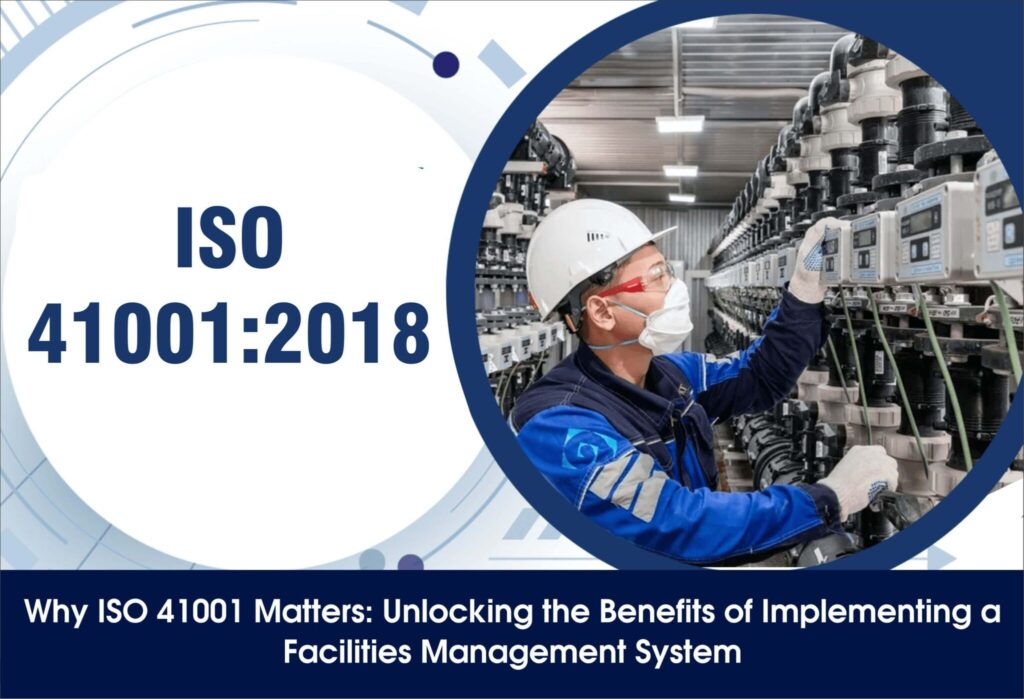
Introduction: Understanding ISO 41001 and its Importance in Facilities Management ⮯ In today’s fast-paced and ever-evolving business landscape, effective facilities management is crucial for organizations to thrive. One essential tool that aids in achieving excellence in facilities management is the ISO 41001 standard. ISO 41001 provides a comprehensive framework for establishing, implementing, maintaining, and improving a facilities management system. ISO 41001 sets forth guidelines and best practices that help organizations enhance their operational efficiency, optimize resource allocation, and ensure the well-being of employees and stakeholders. By implementing ISO 41001, businesses can streamline their facility management processes, improve productivity, and reduce costs. The benefits of adopting ISO 41001 are far-reaching. It enables organizations to enhance their decision-making processes by providing a systematic approach to managing facilities. It also helps in identifying potential risks and opportunities for improvement within the organization’s facilities management practices. Moreover, ISO standards play a vital role in ensuring consistency and quality across industries. By adhering to internationally recognized standards such as ISO 41001, organizations demonstrate their commitment to excellence and gain a competitive edge in the market. We will focus on the importance of ISO 41001 in facilities management. We will explore its key components, the benefits of implementation, and how it contributes to overall organizational success. So, let us embark on this journey towards understanding the significance of ISO 41001 in driving effective facility management practices. Streamlining Operations and Improving Efficiency with ISO 41001 ⮯ Organizations are constantly seeking ways to streamline their operations and improve efficiency. One effective approach to achieving this is by implementing ISO 41001, the international standard for facilities management. ISO 41001 provides a framework that enables organizations to optimize their resources and enhance operational excellence in the field of facilities management. By streamlining processes and aligning them with industry best practices, companies can effectively manage their facilities, reduce costs, and improve overall efficiency. This standard focuses on key areas such as strategic planning, resource allocation, performance measurement, and continuous improvement. By adopting ISO 41001, organizations can establish a systematic approach to managing their facilities, ensuring that they are well-maintained and meet the needs of their occupants. One of the major benefits of ISO 41001 is its ability to optimize resources. By implementing this standard, companies can identify areas where resources are being underutilized or misallocated. This enables them to make informed decisions on how to allocate resources more effectively, leading to cost savings and improved operational efficiency. Furthermore, ISO 41001 helps organizations streamline processes by providing guidelines for effective facility management practices. It encourages a proactive approach towards maintenance and repairs, reducing downtime and minimizing disruptions in operations. This ultimately leads to increased productivity and customer satisfaction. Enhancing Safety and Compliance through ISO 41001 Certification ISO 41001 is a globally recognized standard for Facility Management (FM) systems. It was published by the International Organization for Standardization (ISO) in 2018. The standard is intended to assist organizations in ensuring that their FM systems are efficient and that they are upholding their obligations for health, safety, and the environment. An effective Facility Management System can be established, put into practice, maintained, and improved with the help of certification to ISO 41000. It applies to any business, regardless of size or the type of work they do. Here’s how ISO 41001 certification can enhance safety and compliance ⮯ Risk Management: Organizations must recognize and control hazards associated with their facilities under ISO 41001. Risks to physical security, health, and safety could all be included in this. Early risk detection allows organizations to act to reduce those hazards, improving overall safety. Regulatory Compliance: Organizations must know and follow all applicable legal and regulatory obligations according to the standard. Laws and regulations from both the local and international levels are included. The organization’s reputation is improved and the risk of legal penalties is decreased through compliance. Continuous Improvement: The FM system is continually improved by ISO 41001. This implies that organizations are always seeking methods to enhance their safety procedures and compliance procedures. Emergency Preparedness: Establishing emergency response plans is another requirement of the standard for organizations. In addition to increasing safety, this makes sure they are ready for any circumstance. Employee Training: Organizations are required by ISO 41000 to give their staff the proper training. They will be better able to perform their jobs safely and successfully if they are aware of their duties. Documentation: The standard mandates complete FM system documentation. This makes it easier for organizations to demonstrate their dedication to compliance and safety, and it creates a transparent record of the actions they have taken to achieve this. A company’s safety and compliance can be greatly improved with ISO 41001 certification. In addition to showing stakeholders that the organization is dedicated to upholding high standards in these areas, it offers a clear framework for managing facilities successfully. Improving Customer Satisfaction and Service Delivery with ISO 41001 ⮯ ISO 41001! The field of customer-focused facilities management is being revolutionized by this incredible standard. By using ISO 41000, you can make sure that your facilities are created and maintained with the needs of your customers in mind, resulting in unmatched client happiness. The era of impersonal, generic service is over thanks to ISO 41001, which places the customer at the centre of everything you do to create a memorable experience that will keep them coming back for more. Customer-centric facilities management is required for ISO 41001 implementation. This entails being aware of the particular requirements and preferences of your customers to customize your services. By doing this, you’ll be able to go above and beyond their expectations and offer a level of service that truly distinguishes you from the competitors. The ISO 41001 standard offers a framework for doing this, guiding you through the steps of determining client requirements, setting up efficient communication channels, and continuously enhancing your service offering. The significance of gathering and analyzing information on customer satisfaction and service performance is emphasized by this standard. You can then decide how to improve
What is Involved in an ISO 27001 Implementation
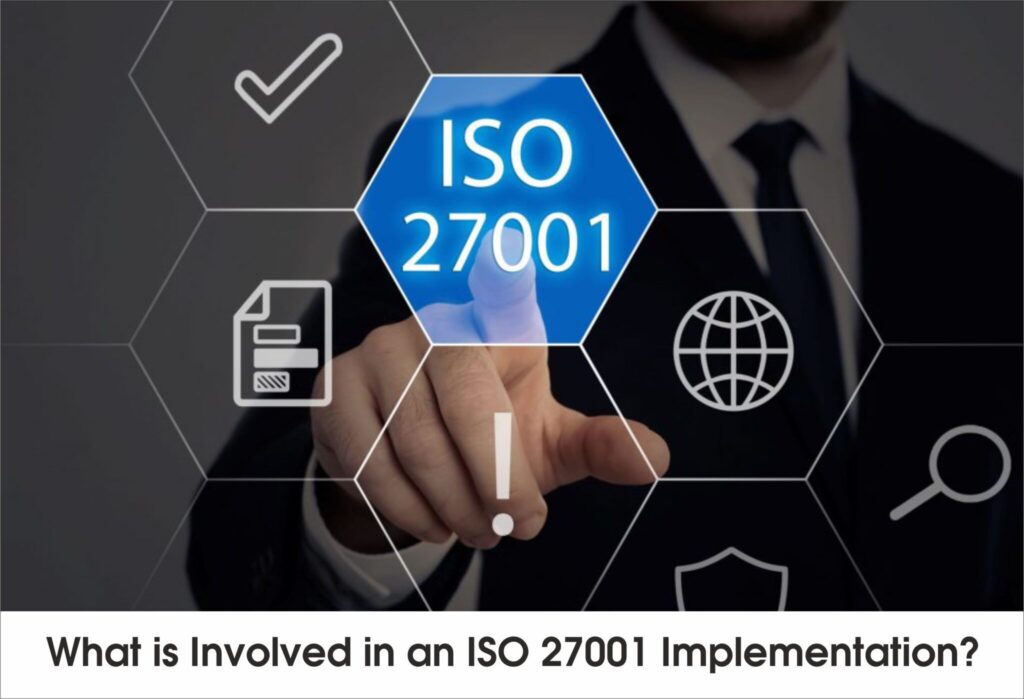
Several essential steps are required for ISO 27001 implementation in order to guarantee an organization’s efficient management of information security. Here’s how it works:- Establishing the context : This stage involves fully understanding the organization’s information security objectives, requirements, and legal responsibilities. It also entails specifying the parameters of the Information Security Management System (ISMS) and the implementation’s scope. Conducting a risk assessment : This stage involves discovering and assessing the risks related to the information assets of the organisation. Evaluation of potential risks, vulnerabilities, and their possible effects are all part of this process. Developing a risk treatment plan : A strategy is developed to manage and minimise risks that have been identified based on the risk assessment. The particular steps that must be taken to lessen or eliminate the risks are outlined in this strategy. Implementing the controls : This stage involves setting up the required procedures and controls to properly manage information security threats. This entails developing and putting into practice rules and processes, making sure that legal and regulatory requirements are fulfilled, and creating systems for observing and evaluating controls. Conducting training and awareness programs : Employees must be informed of their responsibility for protecting the security of information assets. Topics including data protection, password security, and incident response protocols should be covered in training programmes. Conducting internal audits : Internal audits that are conducted on a regular basis assist in identifying areas for improvement and evaluate how well controls have been implemented. These audits make sure that the Information Security Management System (ISMS) is operating according to plan and in accordance with ISO 27001 certification requirements. Conducting management reviews : The ISMS should be reviewed by top management on a regular basis to make sure it remains appropriate, sufficient, and effective. This review involves evaluating internal audit findings, going through safety incidents, and considering any context changes for the organisation. Overall, implementing ISO 27001 requires a methodical strategy that includes risk assessment, control implementation, personnel training, and continual monitoring and improvement. It is an extensive framework that gives organisations the tools they need to properly manage information security threats and safeguard their valuable resources.
